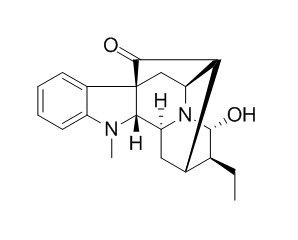Ajmalidine
Standard reference
Inquire / Order:
manager@chemfaces.com
Technical Inquiries:
service@chemfaces.com
Tel:
+86-27-84237783
Fax:
+86-27-84254680
Address:
1 Building, No. 83, CheCheng Rd., Wuhan Economic and Technological Development Zone, Wuhan, Hubei 430056, PRC
Providing storage is as stated on the product vial and the vial is kept tightly sealed, the product can be stored for up to
24 months(2-8C).
Wherever possible, you should prepare and use solutions on the same day. However, if you need to make up stock solutions in advance, we recommend that you store the solution as aliquots in tightly sealed vials at -20C. Generally, these will be useable for up to two weeks. Before use, and prior to opening the vial we recommend that you allow your product to equilibrate to room temperature for at least 1 hour.
Need more advice on solubility, usage and handling? Please email to: service@chemfaces.com
The packaging of the product may have turned upside down during transportation, resulting in the natural compounds adhering to the neck or cap of the vial. take the vial out of its packaging and gently shake to let the compounds fall to the bottom of the vial. for liquid products, centrifuge at 200-500 RPM to gather the liquid at the bottom of the vial. try to avoid loss or contamination during handling.
Pak J Pharm Sci.2023, 36(1):51-57.
Int J Vitam Nutr Res.2022, doi: 10.1024.
iScience.2023, 26(9):107602.
Food Chem.2019, 275:746-753
Nat Prod Sci.2014, 20(3):182-190
Nutrients.2023, 15(6):1335.
Pharmaceuticals (Basel). 2021, 14(10):986.
Molecules.2020, 25(23):5609.
Applied Biological Chem. 2020, 26(63).
Nat Prod Sci.2019, 25(3):238
Related and Featured Products
Tetrahedron.1957;1(4):328-337.
Alkaloid studies–XIX: Alkaloids of some Hawaiian Rauwolfia species: The structure of sandwicine and its interconversion with ajmaline and ajmalidine.[Reference:
WebLink]
METHODS AND RESULTS:
The alkaloid composition of the following three Hawaiian Rauwolfia species–R. sandwicensis A.DC., R. degeneri Sherff and R. mauiensis Sheriff–was determined. Aside from the known aklakoids serpentinine, ajmaline, tetraphylline and tetraphyllicine there were encountered trace amounts of two new dihydroindole alkaloids, mauiensine and sandwicensine as well as larger quantities of an isomer of ajmaline, which was named sandwicine (C20H26N2O2). Since sandwicine and ajmaline yield different dihydro derivatives which are convertible by lead tetra-acetate oxidation to a common indole hemi-acetal, sandwicine represents the C-17 epimer of ajmaline.
CONCLUSIONS:
Dihydrosandwicine was found to be identical with tetrahydroAjmalidine, the sodium borohydride reduction product of Ajmalidine, thereby proving that Ajmalidine is 17-dehydroajmaline.
Joint Malaysia-UK Symposium on Natural Product Chemistry and Drug Discovery. 2014.
Distribution of indole alkaloids in Indian Rauvolfia species.[Reference:
WebLink]
METHODS AND RESULTS:
The major alkaloid distributed in the Rauvolfia species endemic to India (R. hookeri and R. micrantha) was identified as reserpiline by NMR studies of the compound isolated by column chromatography of the alkaloid extract. Further, reserpiline with Rf value close to reserpine, has been identified as a compound that can interfere in the HPTLC and HPLC estimation of reserpine. Other indole alkaloids ajmalicine, Ajmalidine, ajmaline, alstonine, deserpidine, sarpagine, tetraphylline, vomilinine and yohimbinic acid were identified by LC-Q-ToF-MS studies 3-4. HPTLC profiling using the marker compounds reserpine, reserpiline and ajmalicine showed close resemblance of the Indian endemic species R. hookeri and R. micrantha.
CONCLUSIONS:
This is the first report of the comparative phytochemical profiling of all the Rauvolfia species in India and the fingerprints will be much useful for the herbal drug industries for quality control measures.



